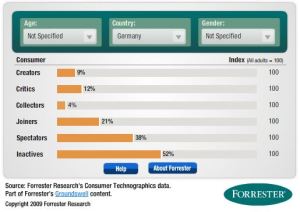Today we learned about Forrester Empowered – a social media tool that enables you to classify consumers into seven overlapping levels of social technology participation. Based on Forrester’s Consumer Technographic survey data, you can monitor how social participation varies among consumers globally and plan a targeted social technology strategy.
Comparing survey data on social participation in Germany and USA, which marketing actions for your business could you derive from the analysis of the data? How could those be implemented in your corporate communications?
If you leave age and gender as not specified and compare USA to Germany, you’ll come to the conclusion that in both countries the majority of consumers is more or less passive (spectators, joiners or inactives). Only 24 % in the USA and 9 % in Germany (!) are active creators, uploading content and sharing first-hand experiences, observations or knowledge.
Most consumers in Germany (over 50 % !) are even inactives, that is users that occasionally browse the web, but don’t have any social accounts neither posting updates nor commenting or liking status updates from others.

Screenshot Forrester US
Source: http://empowered.forrester.com/tool_consumer.html

Screenshot Forrester Germany
Source: http://empowered.forrester.com/tool_consumer.html
In comparison to Germany nearly two third of the consumers in the United States at least browse the web occasionally (spectators). It seems that the internet is more commonly used in general. In the USA 37 % of the consumers are classified as critics compared to only 12 % in Germany and 21 % are classified as collectors compared to only 4 % in Germany. Why are German consumers so incommunicative? And which conclusions could be drawn from the data for your business?
Choosing a target group for my business (age: 25-34, gender: not specified) the numbers vary slightly: as most consumers are still classified into spectators or joiners I would try provide highly attractive content and call for action on a low level of engagement first (e.g. like us and share). By listening to online conservations of creators, critics and conversationalists within the targeted group I’d try to determine topics, issues and keywords that are relevant to my consumers adapting the content step by step.

Forrester Target Group
Source: http://empowered.forrester.com/tool_consumer.html
Levels of social technology participation (defined by Forrester)
Creators: make the social content consumed by others. They write blogs or upload videos, music or text.
publish a blog, publish own web pages, create and upload video, create and upload audio/music, write articles or stories and post them (at least monthly)
Conversationalists: voice their opinions to other consumers and businesses using vehicles like SNS and Twitter
update status on a social networking site, post updates on Twitter (at least weekly)
Critics: respond to content from others. They post reviews, comment on blogs, participate in forums and edit wiki articles
post ratings/reviews of products or services, comment on someone else’s blog, contribute to online forums, contribute to/edit articles in a wiki (at least monthly)
Collectors: organize content for themselves or others using RSS feeds, tags, and voting sites like Digg.com
use RSS feeds, vote for websites online, add tags for web pages or photos (at least monthly)
Joiners: connect in social networks like MySpace and Facebook
maintain profile on a social networking site, visit social networking sites (at least monthly)
Spectators: consume social content including blogs, user-generated videos, podcasts, forums or reviews
read blogs, listen to podcasts, watch videos from other users, read online forums, read costumer ratings/reviews, read tweets (at least monthly)
Inactives: neither create nor consume social content of any kind
Taken together, these groups make up the ecosystem that forms the groundswell. By understanding where your costumers fall within the ladder you can determine which sorts of strategies make sense to reach those costumers.
Social Technographics Defined
